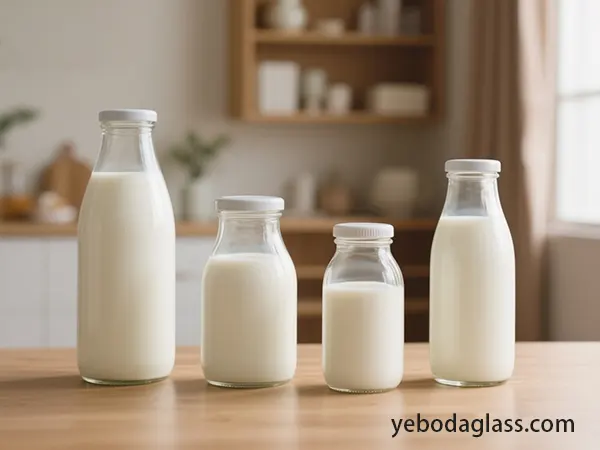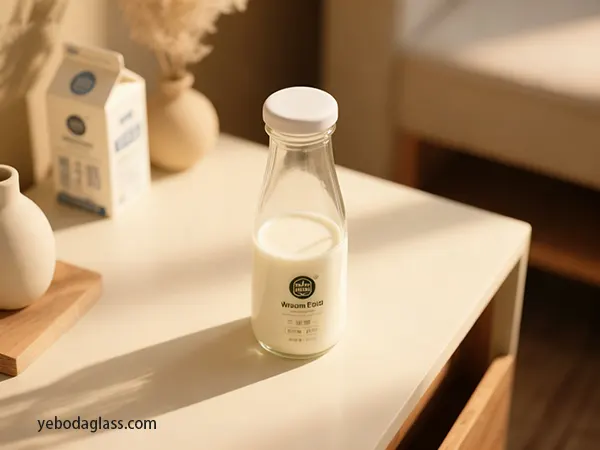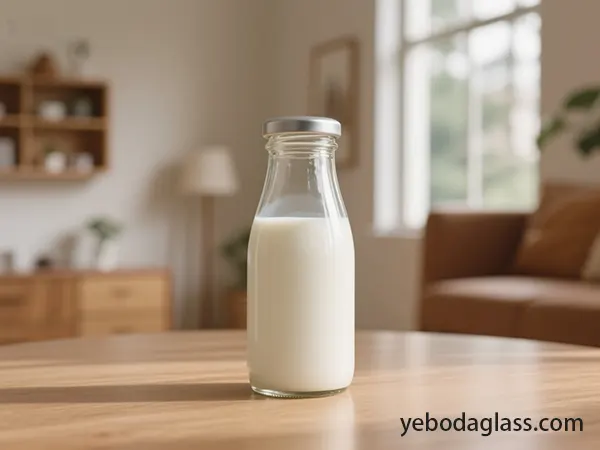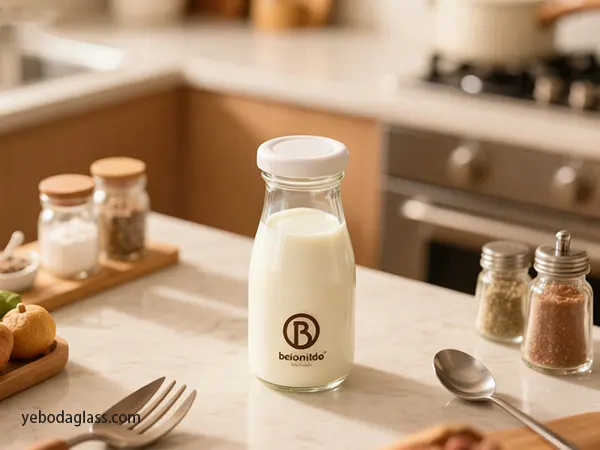Introducción
The objective of this report is to improve the sourcing and supply of milk bottles by working closely with specially designed manufacturers of milk bottles. This move is less about purchasing goods and more about a strategic partnership that facilitates instant savings in raw material, production and in logistics costs, besides generating renewable benefits in sustainability, innovation and resilience. By having a well-organized partnership with a qualified milk bottle manufacturer, a company not only guarantees a stable supply and good quality but also gets the opportunity to use new packaging technologies, cost transparency, and the joint innovation potential. At the end of the day, this system gives businesses the power to increase their profits and stay competitive in the changing global packaging market. As an example, Yeboda, a high-quality glass milk bottle manufacturer, is a partner that technically accurate, environmentally friendly, and reliable in terms of supply. By using advanced glass forming technology and being strongly committed to recycling, Yeboda is a perfect example of how a cost-efficient milk bottle manufacturer can be environmentally responsible at the same time.

Current Milk Bottle Cost Landscape and Specifications
The full cost of milk bottles has to be understood clearly to be able to find optimization opportunities. Costs take up space from materials to transport, quality control, and the purchase of new equipment.
Primary Cost Components
Raw Materials
- Plástico (PET, HDPE): These materials are energy-intensive and their prices are affected by the oil market. PET and HDPE may constitute 50–70% of the total cost of milk bottles. The environmental goal is supported by using recycled versions (rPET, rHDPE) of the products which cause a little extra cost.
- Vaso: Glass is the perfect packaging for milk as it offers purity and stability but the energy needed for the melting process is quite high. Yeboda, as a glass milk bottle manufacturer, is lowering the energy consumption of the melting process by producing with a high percentage of cullet (recycled glass) and using energy-efficient furnaces.
- Additives and Colorants: Additives protect the product from UV, improve its look and increase its mechanical strength.
Logistics
Transportation is one of the leading contributors to costs, most notably in the case of botellas de leche de vidrio because of their heavy and fragile nature. The costs associated with inefficient freight usage and return logistics (empty miles) can be substantially brought down through proper planning and execution of freight operations.
Production Overhead
Energy, labor, maintenance, and depreciation are factors that collectively contribute to the total cost of a bottle. By using energy-efficient blow molding machines and automating quality control through the implementation of robotic inspection systems, the investment pays for itself in a relatively short period of time.
Specific Material and Design Requirements
Their material and design must not only guarantee safety and functionality but also correspond aesthetically to the brand’s positioning.
Material:
- Glass is a product that has a high-end connotation and is fully recyclable.
- PET/HDPE are low weight and cost-efficient alternatives.
- Design: Most design features such as ergonomics, labeling surface area, and stackability remain dominant criteria.
- Aseptic Compatibility: Milk bottles ought to be able to keep their sterility after being subjected to sterilization and after filling under aseptic conditions.

Strategic Partnership Models for Cost Optimization with a Leading Milk Bottle Manufacturer
One of the ways to significantly deepen efficiency and create a shared value pool is to set-up collaborative relationships with a specialized milk bottle manufacturer. The following models indicate different extent integration degree and cost advantage.
Long-Term Supply Agreements (LTSAs)
Within these agreements, there are volume commitments over several years at the agreed rates. They provide supply stability and thus it is possible for the milk bottle manufacturer to schedule production and tooling more efficiently, so that the unit costs are reduced.
Joint Ventures (JVs)
In a JV, decision power as well as investment and risk are equally shared between the partners. The biggest advantage of this structure is that there is no barrier to transparency in production, there is an easy implementation of lean manufacturing and Joint Research and Development into milk bottle innovation is happening.
Co-Location Partnerships
A milk bottle manufacturer can set up a production line closest to the filling facility. This model helps to free the transport costs, diminish the breakage risk and enhance quality collaboration in real-time—just perfect for high-volume milk bottles and aseptic products.
Vertical Integration
Having full ownership of a milk bottle manufacturing facility is the most significant way to get control of the raw materials, technology, and logistics though it requires a big capital outlay and operational expertise.
Leveraging Volume and Growth for Enhanced Savings
Any business that is into packaging can cut down on costs significantly and also improve their operational efficiency by going into a strategic partnership with a milk bottle manufacturer. Out of all negotiation levers, production volume is the most influential one by far. An increase in order quantity not only gives you more negotiating power but also the manufacturer will be more willing to invest in technology, automation, and process stability that in the end will be their as well as your customers’.
Economies of Scale for Milk Bottle Manufacturers
By producing a large number of products, the milk bottle manufacturer is able to set up a dedicated production line, take advantage of bulk raw material purchasing, and reduce per-unit labor and energy costs. For example, a contract for custom glass milk bottles for a long period can be a reason for producers such as Yeboda to invest in the latest fully automated glass blowing machines, design molds tailored to your brand, and production scheduling optimizing. These gains lead to not only consistent product quality but also a lower cost per bottle overall.
Favorable Negotiation Terms
First and foremost, it is worth noting that a production commitment of such a considerable magnitude paves the way for the establishment of advantageous commercial conditions. When a manufacturer of milk bottles is assured of steady volume and reliability, it will consequently offer better pricing structures, more relaxed payment terms, and more detailed Service Level Agreements (SLAs). The agreements can feature measurable KPIs for quality level (defect rates), lead times, and sustainability goals thus creating a perfect equilibrium between cost savings and continuous quality standards.

Future Growth Integration
Embedding growth forecasts in supply contracts is a very important aspect in the evolution of the brand-supplier relationship towards long-term partnerships. The milk bottle manufacturer, having a clear demand increase forecast, can plan for a scalable capacity, invest in new technologies, and even get hold of advantageous pricing for future production runs. This strategic move towards the future not only guards against market upheavals but also guarantees supply stability and maintaining a competitive edge as your brand grows.
Strategic Benefits Beyond Cost Reduction
Unit cost savings through a long-term partnership with a milk bottle manufacturer is just the tip of the iceberg – the relationship actually supports brand strength, resilience, and innovation potential.
Resiliencia de la cadena de suministro
Joint planning improves trust and risk lessening e.g., shortage of raw materials or transport problems. The milk bottle producer hence turns into your business’s most reliable operational arm.
Sustainability Synergies
Producers operating advanced recycling systems may welcome far more post-consumer resources (rPET, glass cullet) without sacrificing product quality. Because of the joint effort in lightweighting and closed-loop recycling, fewer emissions and less waste are the result.
Packaging Innovation
By utilizing R&D resources from a technologically advanced milk bottle manufacturing partner, the company can achieve ergonomic designs, improve barrier properties, and aesthetic refinement. It allows continuous product differentiation in a fiercely competitive market.
Maximizing the Partnership Model with a Milk Bottle Manufacturer
Clear governance, performance monitoring, and mutual innovation frameworks are some of the factors that enable you to fully benefit from the collaboration.
Contractual Framework
Long-term agreements should reflect the planned volumes, cost change mechanisms, and sustainability targets. Improvement, as well as sharing the cost in a transparent way, must be the commitment of both parties.
Joint Governance and Communication
A joint committee provides a platform to both parties for performance metrics, innovation initiatives, and production efficiency reviews on a regular basis. This is really helpful for maintaining alignment and solving issues at the spot.
Integrated Innovation Pathway
Collaborative innovation initiatives enable the milk bottle manufacturer and the buyer to work together on designing the next-generation packaging—making it more recyclable, efficient in barrier properties, and lighter.
Recomendaciones estratégicas y perspectivas futuras
Core Recommendations
- Start by doing a Total Cost of Ownership (TCO) analysis to expose the inefficiencies hidden in procurement and logistics.
- Pick a milk bottle manufacturer who is not only aligned with your cost objectives but also with your sustainability goals.
- Place partnership models (LTSAs and co-location) priority that best match flexibility and investment.
- Make sure that contracts have the inclusion of the specific sustainability metrics (recycled content %, energy efficiency) etc.

Long-Term Outlook
Collaboration ecosystems that combine automation, data analytics, and sustainability are where the milk bottle manufacturing industry is headed. Companies that form strategic partnerships will be the ones that have a competitive advantage the most as these partnerships transform packaging from being a cost center into a brand asset. Through partnership with an efficient milk bottle manufacturer, companies are able to ensure operational stability, meet sustainability requirements, and keep on innovating. In this changing environment, the ideal partnership is more than just a supplier relationship; it is a strategic alliance that shapes the future of packaging excellence.




